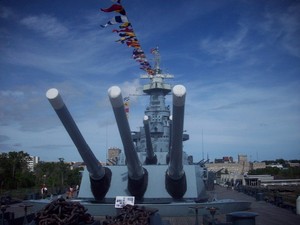Battleship is a guessing game played between two players. The objective is to sink your opponent’s battle ships on a hidden map or board. Battleship began as a pencil and paper navy game played during WWI by soldiers all around the world. The first printed version of the game consisted simply of disposable game play papers so that players did not have to draw out their map on graph paper and pencils. These simple versions of the game were published in the early 1930s. In 1967, well-known toy manufacture Milton Bradley gave Battleship the appearance most people recognize, a set of plastic laptop looking peg-holed maps in which tiny plastic ships are placed.
Battleship can still be played today with paper and pencil or on the actual board game. The paper version is an effective tool to teach kids to use coordinates and locate points on a graph. This simple guide on how to play battleship will explain how to play both versions of battleship as well as look at some of the alternative versions of the game that have evolved over time.
How to play Paper Battleship:
Battleship can be played on any type of paper but graph paper is the easiest to use. First you’ll need to either draw or print out 2 battleship playing maps. These maps are a set of two graphs with the letters A through H on one side, and the numbers 1 through 8 on the other axis. One graph is for the player to mark their own ships, the other is to mark locations one has “shot at”.
Each player draws seven ships on their battleship graph. Ships are represented by the first letter of their name in a number of grid squares that represent their length.
The battleship ships and lengths are as follows:
*1 Aircraft carrier, 5 spaces long
*1 Battle ship, 4 spaces long
*1 Cruiser, 3 spaces long
*2 Destroyers, 2 spaces long
*2 Submarines, 1 space long
Ships can be placed only vertically or horizontally and may not occupy the same space on the grid. Players should place something between them so they cannot see one another’s graphs.
Once both players have placed their boats game play begins. Generally, the youngest player goes first simply by calling out a coordinate on the graph such as A3 or D6. The other player then responds either “Miss” or “Hit” and the name of the ship hit. A ship is not sunk until each space of it has been hit. A player must sink all of their opponents ships to win. Paper Battleship can be a great way to help kids learn about graphing.
The board game Battleship:
The board game Battleship is played very similarly to the graph paper version; however, each drawn graph is replaced with a plastic peg filled grid on the board. A Battleship playing board consists of two halves and opens like a laptop or briefcase. The top half of a Battleship board that opens up to stand vertical is for placing pegs in locations you have “shot at”, the bottom half which rests on the floor or table is for placing your plastic battleships. The shape of the board prevents other players from peeking at the other’s ship locations.
The ships in the board game are the same as those in the graph paper version except there is only one type of each ship, and submarines are three spaces long rather than one. Game play is also done in the same manner as the paper version with one player calling out a coordinate and the other stating whether it is a hit or miss. Misses are marked with white pegs and hits are marked with red pegs.
Winning is again achieved by sinking all of your opponent’s ships.
The evolution of Battleship:
Battleship has been around since the 1930s; because of this there are many versions and alterations of the game. Two of the major alternative versions of the game have already been covered here, the first board game version and the printed map version.
The next big leap in Battleship game versions came in 1983 with the invention of an electronic version with lights and sounds for when ships where hit, missed or sunk. Electronic versions are played in the same way as the board game Battleship but are a bit more modern. There have also been aircraft versions of the game made rather than water-based crafts and several movie inspired spin-offs such as Star Wars Battleship and Pirates of the Caribbean Battleship.
The final evolution of the simple paper and pencil game was found in 1991 with the single player computer game, minesweeper. There are also varieties of handheld electronic single or two player versions. Battleship can even be played on most game consoles such as Xbox.
